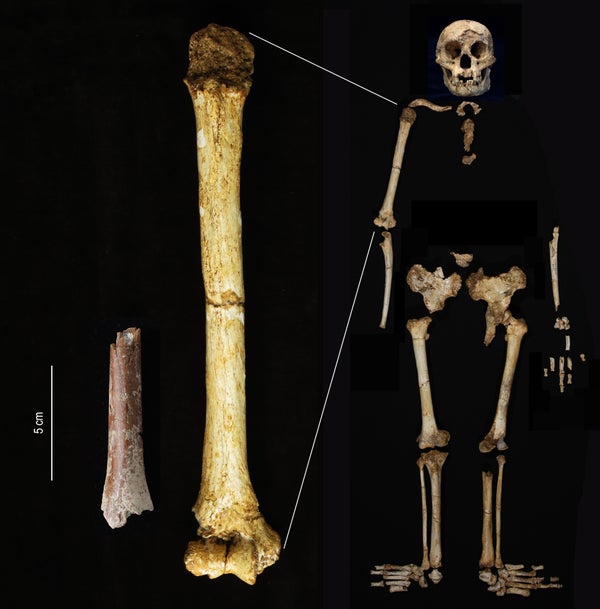What Does the ‘Hobbit’ Fossil Discovery Teach Us about Our Tiny Human Relatives?
A tiny human relative called the Hobbit, or Homo floresiensis, may have evolved from a larger ancestor that shrunk upon arriving on the Indonesian island of Flores, a new fossil suggests
The humerus fragment discovered at Mata Menge on the Indonesian island of Flores is shown at the same scale as the Homo floresiensis one found nearby in the Liang Bua cave.
The origin story of Homo floresiensis, an oddball member of the human family that lived as recently as 60,000 years ago on the Indonesian island of Flores, is coming into focus. With its miniature body and brain and relatively big feet, H. floresiensis came to be known as the hobbit. Scientists have long puzzled over how the hobbit evolved its peculiar proportions. Now the discovery of a tiny fossilized arm bone from an early member of the species that lived some 700,000 years ago may help settle the matter.
In 2004 researchers announced they had found the first H. floresiensis remains—a nearly complete skull and partial skeleton of a female individual that lived about 80,000 years ago—buried in a cave called Liang Bua on Flores.
This female skeleton, dubbed LB1, is a “type specimen,” or representative of the species. From LB1, scientists estimate the individual stood about three feet, six inches (106 centimeters) tall, with a grapefruit-size brain and feet that were more than half the length of their thighbones. Along with bones from other individuals found in the cave, dating to between about 100,000 and 60,000 years ago, LB1 showed that the hobbit skull had characteristics more like our close human relative Homo erectus, though the rest of its body seemed to align with more primitive species such as Australopithecus afarensis (the most famous skeleton of which is called Lucy).
On supporting science journalism
If you’re enjoying this article, consider supporting our award-winning journalism by subscribing. By purchasing a subscription you are helping to ensure the future of impactful stories about the discoveries and ideas shaping our world today.
For years, debate has centered around the origin of this population. Researchers have argued about whether it arose from an already small, primitive early human, such as Homo habilis or an Australopithecus species, or from a bigger-bodied, larger-brained H. erectus that shrunk under the pressures of island life. A third argument that was taken off the evolutionary table was that these were modern humans with a condition that caused dwarfism.
In 2016 scientists unveiled a lower jaw fragment and small teeth that appeared to belong to a more primitive H. floresiensis at the site of Mata Menge, about 70 kilometers from the Liang Bua site on Flores. These fossils, which came from at least three individuals, dated back 700,000 years, well before modern humans emerged anywhere on Earth. (The oldest fossils from an anatomically modern human date to around 315,000 years ago in what is now Morocco.) The researchers argued that similarities between those tooth and jaw remains suggested that a larger hominin (a member of a group containing modern humans and their extinct relatives), possibly H. erectus, traveled from the Indonesian island of Java and got stuck on Flores, where it evolved smaller proportions, eventually giving rise to the tiny H. floresiensis.
Researchers led by Yousuke Kaifu of the University of Tokyo recovered the new arm bone—an incomplete humerus measuring just 8.8 centimeters long—from Mata Menge, along with some additional teeth. The arm fossil is the first bone from below the skull to emerge from this site.
The researchers had to estimate how long the bone would have been when the individual was alive, and then they used that length to estimate the hominin stood about 100 cm tall, or 6 cm shorter than the estimated height of the individuals from Liang Bua, says study researcher Gerrit van den Bergh of the University of Wollongong in Australia.
The newly discovered teeth also contain clues. One of them showed similarities with those from H. erectus found on Java and is less specialized than the H. floresiensis teeth from the Liang Bua cave, van den Bergh says.
Importantly, all the Mata Menge remains are small. The teeth mandible and humerus are all smaller than those found at Liang Bua, Kaifu says. “This means that, 700,000-years-ago, Homo floresiensis was at least as small as, or even slightly smaller than, the 60,000-years-ago Homo floresiensis from Liang Bua,” he adds.
The findings suggest that “once a population of Homo erectus got stranded on Flores one million years ago, there was no more genetic exchange with mainland hominins, and the large-bodied Homo erectus evolved to the smaller Homo floresiensis by a process called insular dwarfing,” van den Bergh says. The same seems to have occurred for Flores’s animals, such as dwarfed species of Stegodon, ancient relatives of elephants: because of food limitations, lack of predators and the loss of the need to search long distances for such food (which is aided by being bigger), creatures shrunk, the thinking goes. Van den Bergh adds that H. floresiensis’ body size could have fluctuated over time because of changing climate and environmental conditions. The species vanished from the fossil record at about the same time that modern humans appeared on the island, about 50,000 years ago.
“This offers a confirmation of what a lot of people expected from the first publication [in 2016], but it brings something new, some post-cranial fossils, not just teeth or jaws or the head,” says Karen Baab, a biological anthropologist at Midwestern University, who has led studies of the hobbit. “This helps to get more directly at body size in this more ancient population on Flores.”
The humerus fragment is missing its ends, which are vital in determining whether the specimen belonged to a child or an adult. The researchers used other proxies that supported the adult tag, however. Without the ends, the estimate for total length is also uncertain, Baab says.
“Having postcranial bones is important to infer things like body size because this is not easy to infer from teeth of cranial bones,” says Aida Gómez-Robles, an anthropologist at University College London, who wasn’t involved in the new study. “But at the same time, what [the researchers] have found is a fragment of a humerus that doesn’t have the ends.”
The hope is that more complete postcranial bones dating back even further in time, closer to the hypothetical emergence of H. erectus on the island, will turn up to paint a more detailed picture of how the hobbit came to be.




















Discussion about this post